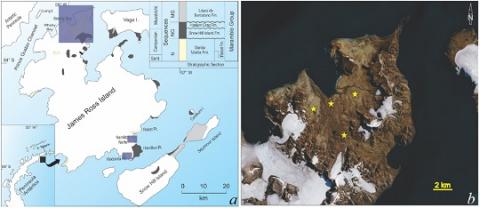F. Milanese, E. Olivero, J. Kirschvink, A. Rapalini
2 016
Latinmag Letters, Volume 6, Special Issue (2016), B21, 1-4. Proceedings São Paulo, Brasil
La Formación Santa Marta (Santoniano-Campaniano medio) se encuentra en el extremo noroccidental
de la Isla James Ross, en la Península Antártica. La Formación Rabot (Campaniano temprano-medio) es
equivalente a la parte superior de la Formación Santa Marta y aflora en el sector sureste de la isla. Debido a endemismo y extinciones diacrónicas, la correlación bioestratigráfica del relleno de la Cuenca James Ross ha sido siempre una tarea problemática. En este trabajo, presentamos una columna magnetoestratigráfica preliminar, compuesta por cuatro secciones de la Formación Santa Marta, que sugiere que la reversión C34n/C33r, equivalente al límite Santoniano-Campaniano, se encuentra registrada en los niveles inferiores de la Formación Santa Marta. Esto es consistente con resultados magnetoestratigráficos previos obtenidos en las formaciones Santa Marta y Rabot y con la correlación bioestratigráfica basada en amonites.
de la Isla James Ross, en la Península Antártica. La Formación Rabot (Campaniano temprano-medio) es
equivalente a la parte superior de la Formación Santa Marta y aflora en el sector sureste de la isla. Debido a endemismo y extinciones diacrónicas, la correlación bioestratigráfica del relleno de la Cuenca James Ross ha sido siempre una tarea problemática. En este trabajo, presentamos una columna magnetoestratigráfica preliminar, compuesta por cuatro secciones de la Formación Santa Marta, que sugiere que la reversión C34n/C33r, equivalente al límite Santoniano-Campaniano, se encuentra registrada en los niveles inferiores de la Formación Santa Marta. Esto es consistente con resultados magnetoestratigráficos previos obtenidos en las formaciones Santa Marta y Rabot y con la correlación bioestratigráfica basada en amonites.
The Santa Marta Formation (Santonian - middle Campanian) is located in the northwestern tip of the James Ross Island, in the Antarctic Peninsula. The Rabot Formation (early-middle Campanian), that is equivalent to the upper part of the Santa Marta Formation, crops out at the southeastern sector of the island. Due to diachronic extinctions and endemism, biostratigraphic correlation of the James Ross Basin infill presents many uncertainties. We present here a preliminary magnetostratigraphic composite section of four outcrops of the Santa Marta Formation which suggests that the C34n/C33r reversal, and therefore the Santonian-Camapanian boundary, is recorded at the lower levels of the Santa Marta formation. This is consistent with previous magnetostratigraphic results on the Rabot Formation and agrees with biostratigraphic correlations based on ammonites associations.

